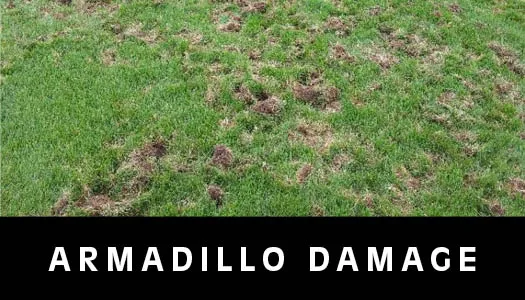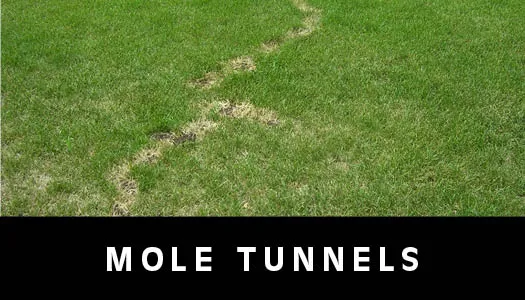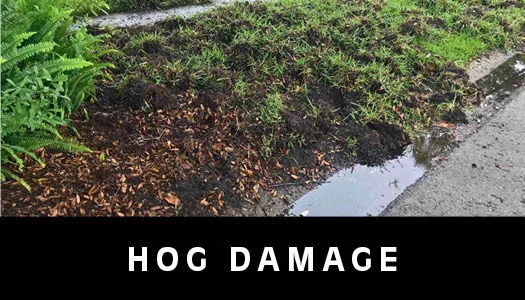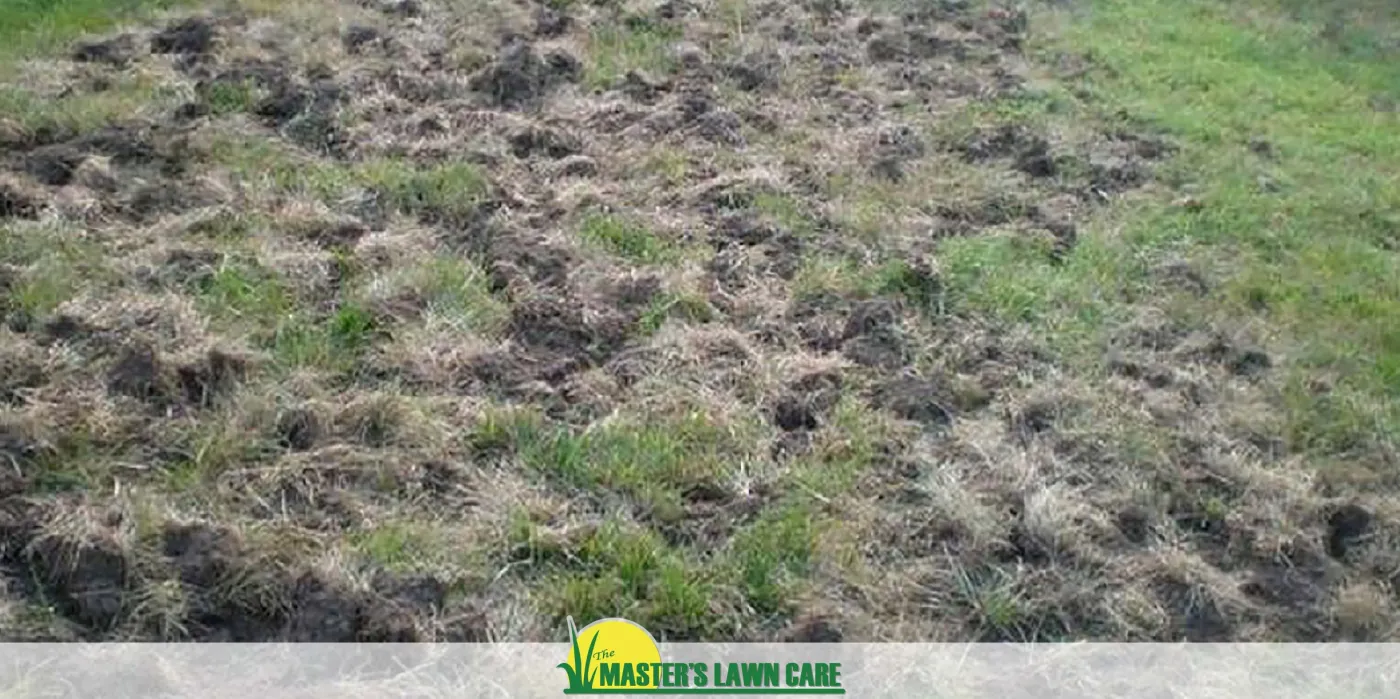We know that dealing with critters in your yard can be a real pain, but there are things you can do to keep the damage and trouble to a minimum. We want to share some tips on how you can identify and manage pesky wildlife such as armadillos, moles, deer, hogs/wild boar, and mosquitoes.
Identifying and Removing Armadillos from your lawn

Signs that Armadillos are in your landscape:
-
Keep an eye out for holes or burrows in the ground that are around 3-5 inches wide and a few inches deep. You might also notice piles of dirt around the burrows, especially near the openings, and the grass torn up in a couple hundred square foot space.
-
Damage to your lawn or garden beds. They like to dig around for insects and grubs, so you might see patches of soil that look rooted up or areas of your lawn that have been dug up. And if you spot small, dark, cylindrical droppings around the burrows, it's a pretty good bet that armadillos are to blame.
If you don't want those pesky armadillos messing up your yard, there are a couple of things you can do:
-
Your best bet is to find there burrow, which is easiest to find by looking around the base of your home. They will typically dig a football sized hole under your foundation, HVAC unit, or shrubbery and there will be a pile of dirt next to the hole where they created their home. Once located, trapping is the most successful way to rid your lawn of these pesky critters. Many pest control companies offer humane wildlife trapping services.
-
If you cannot find their home, trapping may still be an option, but you might be less successful. Locating their entry point (if your yard is fenced in) may be your second best option. If you find where they’ve dug under your fence, use chicken wire or any type of fencing to keep them from coming back.
-
If trapping or excluding them doesn’t work, your last chance for success is eliminating their food source - grubs and insects. We offer a lawn pest and grub control program which can protect your lawn from grubs and help it recover from the armadillos.
-
A handy DIY trick that we cannot confirm works is to try using castor oil or rags soaked in ammonia to make them steer clear of certain spots in your lawn. Exclusion and trapping are the most effective and proven solutions.
Identifying and Removing Gopher Moles from your Lawn

There are a few signs that suggest you might have moles in your yard:
-
Look out for raised ridges or mole hills on your lawn, which are created as moles tunnel just below the surface of the soil.
-
You might also see shallow tunnels or ruts in your lawn, caused by moles as they search for insects to eat. These can make it difficult to mow your grass.
-
Gopher Moles are most noticeable in areas where the grass is thin or they frequently travel, such as against your driveway or sidewalk as their tunnels run along them.
Although they aren’t typically the only cause of the lawn’s struggle - they absolutely do contribute to it by creating air pockets at the roots allowing turf roots to dry out.
-
Talpirid mole baits and other similar brands work well if you’re patient, although they do take some time and consistency to be effective. Make sure to put them in the mole's most frequented tunnels (typically near concrete where they tunnel paralel to it) and be sure to use gloves (this keeps your scent off the baits).
-
Similarly to Armadillos, our grub and lawn pest control program will help reduce the grubs and help the lawn improve from other struggles helping the mole tunnels become more visible.
-
Here's a YouTube video made by our friend, Allyn Hane, the LCN about different types of mole traps to use.
-
You can also try this approach (just kidding!)
Identifying Deer Plant Damage and Keeping them from your Landscape
If you suspect that deer are munching on your landscape, there are a few signs to look out for:
-
The most obvious signs are damage to your plants, including bite marks on leaves, broken branches, and completely stripped foliage. New plants pulled out of the ground are also a common sign, as they test them to see if they’re tasty.
-
Another indication is the presence of tracks or droppings in your yard. Deer tracks are typically heart-shaped and leave imprints, while their droppings are small and round.
If you find that deer are treating your landscape plants like a buffet, you've got a couple of options, but know that none of them are simple - especially if you live in the San Felasco area. Those are some of the boldest and most persistent deer we have ever dealt with.
-
First, plan your landscape design with deer-resistant plantings such as Drift Roses, Snapdragons, Flax Lilies, Camellias, and Hollies that deer are seldom interested in. Sometimes designing with nature in mind is easier and more prudent than fighting your surroundings.
-
Exclusion works well if you want to grow things they will see as tasty - such as a garden or certain flowers. Put up some high fences to keep them out.
-
Another idea is a motion-detected sprinkler head. We have used these regularly in landscape installations where deer are common and may want to taste the new plants - even though they are deer-resistant.
Identifying Hog or Boar Damage and Protecting your Landscape from them.

Signs that hogs might be causing damage to your landscape:
-
You might notice areas of soil that have been rooted up, creating large patches of bare ground. Hogs use their strong snouts to dig for food, and this can create large damage to lawns - significantly worse than either moles or armadillos.
-
Hogs may leave behind tracks or droppings in your yard. Hog tracks are typically round or oval-shaped and have distinctive imprints from their cloven hooves. Their droppings are also large and cylindrical in shape.
-
Another sign to look out for is damage to plants or crops, as hogs are known to eat a variety of vegetation, which is unlike armadillos or moles. They may leave behind bite marks on leaves or chew through stems and roots similar to deer - but deer do not tear up the lawn.
Hogs and Boar can be a real disaster for your yard, so it's crucial to act fast once you spot them. You've got a few options here, but really only two are successful:
-
Put up a fence to exclude them from your backyard. This is common in Nocatee where there are so many natural preserves and hogs are invading backyard lawns neighboring the preserve to search for food. Although it isn’t ideal, the hogs will just move on to the neighbor’s lawn.
-
If a fence isn’t practical for you, the next best thing to do is trap them. Please note than HOAs may have different rules and regulations in regards to this, so contact your local HOA board to request how to address the issue to avoid unexpected violations.
Reducing and Controlling Mosquitoes in your yard:
If you have mosquitoes swarming your yard, it is almost impossible to enjoy your outdoors. Take these steps to get rid of them.
-
Get rid of any stagnant water around your place.Here’s a few of the most common sources of standing water around your home that mosquitoes love
-
Ensure good drainage in your yard. Eliminate spots in your yard that are prone to puddling or stagnant water collecting.
-
Start a Mosquito Pest Treatment Program or install a mosquito misting system
For more information on mosquitoes, please feel free to use this resource that goes more in-depth on mosquitoes as a whole.
When dealing with wildlife damaging your landscape or ruining your time outdoors, it's important to follow local and state laws and regulations. There are many effective methods available for preventing damage from deer or controlling the presence of armadillos or moles that are both safe and humane. Take the time to identify the wildlife in your yard and use the right methods for control to ensure a healthy and balanced ecosystem in your landscape.


